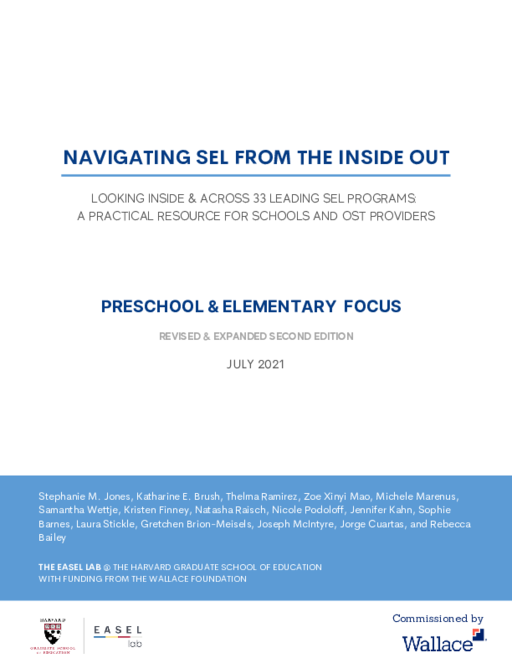- Author(s)
- Stephanie M. Jones, Katharine E. Brush, Thelma Ramirez, Zoe Xinyi Mao, Michele Marenus, Samantha Wettje, Kristen Finney, Natasha Raisch, Nicole Podoloff, Jennifer Kahn, Sophie Barnes, Laura Stickle, Gretchen Brion-Meisels, Joseph McIntyre, Jorge Cuartas, and Rebecca Bailey
- Publisher(s)
- Harvard Graduate School of Education
Research Approach
This report reflects a detailed content analysis of 33 leading SEL programs. It identifies and summarizes key features and attributes of SEL programs for preschool and elementary-age children to help schools and OST providers make informed decisions.
Researchers first identified programs for inclusion in this guide. They included 24 programs from the original 2017 Navigating SEL Guide and nine additional programs selected based on specific inclusion criteria. These included:
- Lessons and activities that fall within the PreK-5 age span;
- Sufficient evidence to indicate impact on social and emotional skills, behavior, academic achievement, attendance, and/or relationships and climate;
- A universal program that could be used in such places as classrooms, afterschool programs, community centers, and early childhood centers;
- A primary focus on SEL or a related field;
- Alignment with the theory and practice of social and emotional learning;
- Accessible and codable materials and implementation information.
Researchers then coded program lessons for the skills they target and instructional methods they employ. They used a coding system developed and refined over the course of multiple projects. This involved a team of coders reading each program’s curricular materials to identify which of 23 specific SEL skills across 6 broad domains of SEL were targeted in each lesson, as well as the instructional methods used to do so. There also was a separate coding system to describe the extent to which program lessons aligned with best practices for equitable SEL. And researchers drew on a standardized process to collect and summarize information about high-level program features and evidence of effectiveness.
Using these data, researchers created program profiles summarizing each program’s domain focus, instructional methods, and program features/components. They also conducted a cross-program analysis to highlight key areas of overlap and variation.
The research was conducted by a research team at the Ecological Approaches to Social and Emotional Learning (EASEL) Lab led by Dr. Stephanie Jones at the Harvard Graduate School Education.



